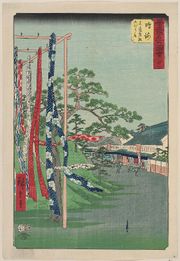Difference between revisions of "Shibori"
Jump to navigation
Jump to search
| Line 10: | Line 10: | ||
<gallery> | <gallery> | ||
| − | File:21.1126_Shibori_tied_det.jpg|thumb|Shibori detail | + | File:MFA211126 Shibori.jpg|Japanese shibori<br>MFA 21.1126 |
| − | File:21.1126_Shibori_untied_det2.jpg|thumb|Shibori detail untied | + | File:21.1126_Shibori_tied_det.jpg|thumb|Shibori detail<br>MFA 21.1126 |
| + | File:21.1126_Shibori_untied_det2.jpg|thumb|Shibori detail untied<br>MFA 21.1126 | ||
</gallery> | </gallery> | ||
Revision as of 11:27, 23 October 2020
Description
A type of resist-dyed textile made by folding, binding, or knotting cloth prior to dyeing. Shibori textiles, first made in Japan in the 8th century, have blended edges to their colored patterns.
Synonyms and Related Terms
resist-dyed textile; kokechi; kechi
Additional images
Resources and Citations
- Yoshiko Wada, Mary K. Rice, Jane Burton, Shibori. The Inventive Art of Japanese Shaped Resist Dyeing: Tradition, Techniques, Innovation, Kodansha International, Tokyo, 1983.



